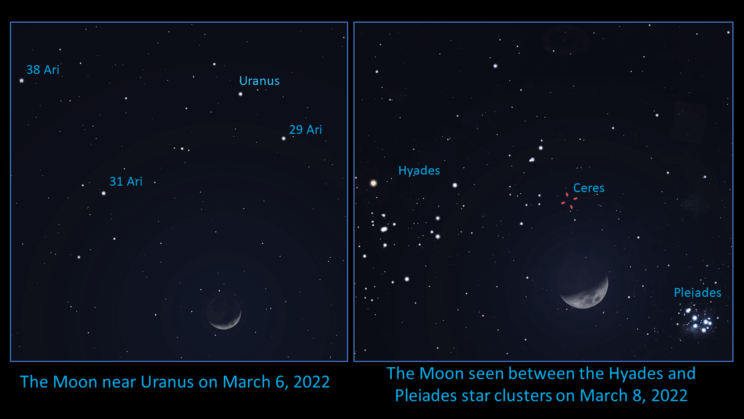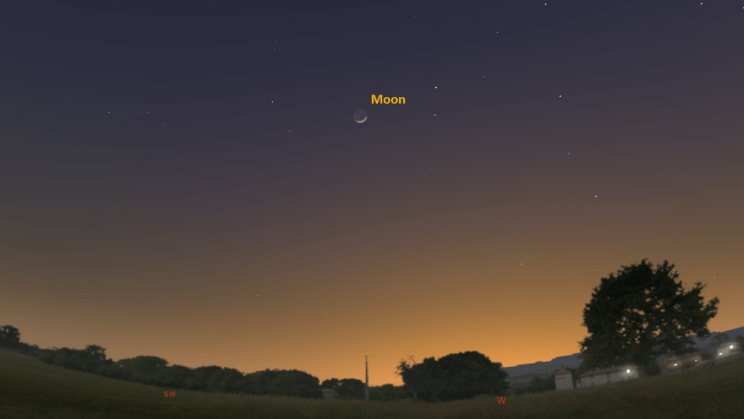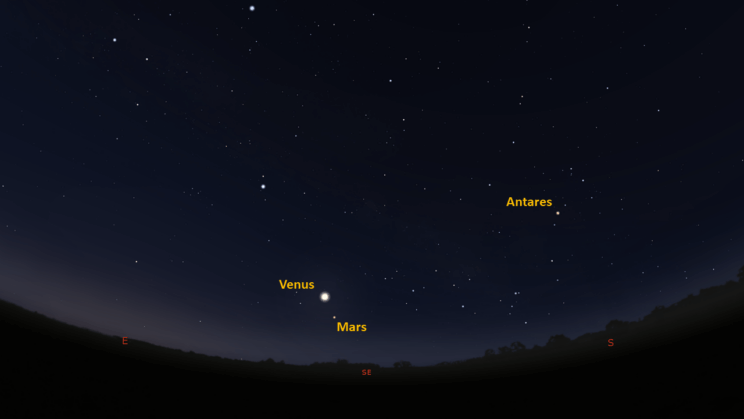This is the Saint Louis Science Center’s NIGHT SKY UPDATE for the week of Friday, March4, 2022.
Information updated weekly or as needed.
Times given as local St. Louis time which is Central Standard Time (CST). For definitions of terminology used in the night sky update, click the highlighted text. If relying on times posted in Universal Time (UT), St. louis is -6 hours when CST.
Public Telescope Viewings
With the changing recommendations from the CDC regarding COVID-19, conversations regarding the return of star parties at the Saint Louis Science Center have begun. We are close to bringing back our public telescope viewings, but a few details still need to be worked out. We will post future updates as we learn more about when we can bring back telescope viewings.
Observing Highlight of the Week

The Moon will be found near the planet Uranus on March 6 and 7, 2022. Follow the Moon this week as it passes by several interesting objects. Image created using Stellarium.
This week the Moon will pass by several objects of interest. This includes a planet and a few open star clusters. A new lunation started on March 2, 2022, and as such the Moon will be found in the west after sunset.
On March 4, 2022, the Moon will exhibit a waxing crescent phase with only 5.9% of the lunar disk illuminated. By March 10, 2022, the Moon will reach first quarter phase. One of the things to look for this week is called ashen moon or earthshine. Sunlight reflecting off Earth dimly illuminates the night portions of the Moon facing us. This allows us to see the entire lunar disk facing Earth. The reverse happens when the Moon is near full moon. As we approach full Moon on March 18, 2022, look outside at night and you may be surprised how bright it is. Sunlight reflecting off the Moon is bright enough that it casts shadows.
If you follow the Moon each night this week you will see it pass through the constellations Pisces, Aries, Taurus and Gemini. When in Taurus on March 8, 2022, the Moon will be found between the Hyades and Pleiades star clusters. The Hyades will be a V-shape of stars left of the Moon and the Pleiades will be found to the right. Both star clusters are a beautiful sight through binoculars.
For those with a telescope or larger binoculars, you can see the Moon near the planet Uranus on March 6 and 7. Finding Uranus will be a bit tricky but using a desktop planetarium such as Stellarium will make it easy. Around 8:00 p.m., Uranus and the Moon will be roughly 2° apart. Uranus will be found to the east of the Moon near the 6th magnitude star 29 Ari. Uranus will have a visual magnitude of 5.8 which should make the 7th planet an easy target though binoculars.
Lastly, the Moon reaches last quarter phase on March 10, 2022, at 4:45 a.m. First and last quarter phases are the terms used when 50% of the lunar disk is illuminated. When Mercury and Venus exhibit similar phases the term for this is dichotomy. Mercury’s next dichotomy is on April 25, 2022, and for Venus it occurs on March 21, 2022. To see the phases of Mercury and Venus you will need to use a telescope. Mercury’s next apparition is in the evening so you will find it in the west after sunset the last half of April. Venus is currently in a morning apparition and as such will be found in the southeast before sunrise.
The Sun and Moon

The Moon as seen from the International Space Station, on July 31, 2011.
Credit: NASA
Sunrise is at 6:38 a.m. on Friday, March 4 and sunset is at 5:50 p.m. providing us with roughly 11.5 hours of daylight. Even after sunset, the light from the Sun will dimly illuminate our sky for roughly 1 hour and 40 minutes. This period is called twilight, which ends around 7:25 p.m. this week. For those with a sundial, local noon occurs around 12:12 a.m. this week.
| Day | Sunrise | Sunset |
|---|---|---|
| 2022-03-04 | 6:28 a.m. | 5:57 p.m. |
| 2022-03-05 | 6:27 a.m. | 5:58 p.m. |
| 2022-03-06 | 6:25 a.m. | 5:59 p.m. |
| 2022-03-07 | 6:24 a.m. | 6:00 p.m. |
| 2022-03-08 | 6:22 a.m. | 6:01 p.m. |
| 2022-03-09 | 6:21 a.m. | 6:02 p.m. |
| 2022-03-10 | 6:19 a.m. | 6:03 p.m. |
| 2022-03-11 | 6:18 a.m. | 6:04 p.m. |
| 2022-03-12 | 6:16 a.m. | 6:05 p.m. |
Moon
Moonrise for Friday, March 4 occurred at 2:52 a.m. and moonset will occur at 12:09 p.m. On Friday, March 4 the Moon will exhibit a waning crescent phase with 27% of the lunar disk illuminated. New moon occurs on March 2, 2022, at 11:35 a.m.
International Space Station (ISS) Observing

Visible passes of ISS from St. Louis for the week of March 4 occur during morning hours. The best pass this week occurs on March 8, 10 and 11. Use the table below for information about these and other visible passes this week.
Catch ISS from St. Louis starting Friday, March 4
| Date | Starts | Max. altitude | Ends | |||||||
|---|---|---|---|---|---|---|---|---|---|---|
| Time | Alt. | Az. | Time | Alt. | Az. | Time | Alt. | Az. | ||
| 06Mar | -1.6 | 05:33:18 | 10 | NNW | 05:36:03 | 22 | NNE | 05:38:46 | 10 | E |
| 07 Mar | -1.2 | 04:46:10 | 13 | NNW | 04:47:51 | 17 | NNE | 04:50:06 | 10 | NNE |
| 08 Mar | -0.7 | 04:00:12 | 13 | NNE | 04:00:12 | 13 | NNE | 04:01:16 | 10 | NE |
| 08 Mar | -3 | 05:33:41 | 10 | NW | 05:36:59 | 51 | NE | 05:40:15 | 10 | ESE |
| 09 Mar | -2.1 | 04:47:15 | 21 | NNW | 04:48:52 | 32 | NNE | 04:51:56 | 10 | E |
| 10 Mar | -1.2 | 04:01:29 | 20 | NE | 04:01:29 | 20 | NE | 04:03:24 | 10 | E |
| 10 Mar | -3.5 | 05:34:26 | 10 | WNW | 05:37:38 | 50 | SW | 05:40:53 | 10 | SSE |
| 11 Mar | -3.8 | 04:48:49 | 49 | NW | 04:49:37 | 87 | NE | 04:52:58 | 10 | SE |
| 12 Mar | -1.4 | 04:03:22 | 22 | ESE | 04:03:22 | 22 | ESE | 04:04:47 | 10 | ESE |
| 12 Mar | -2 | 05:36:20 | 12 | W | 05:38:00 | 16 | SW | 05:40:11 | 10 | S |
Magnitude (Mag): The Measure of brightness for a celestial object. The lower the value is, the brighter the object will be.
Altitude (Alt): The angle of a celestial object measured upwards from the observer’s horizon.
Azimuth (Az): The direction of a celestial object, measured clockwise from an observer’s location with north being 0°, east being 90°, south being 180° and west being 270°.
For information about ISS flyovers and other visible satellites, visit www.heavens-above.com
Detailed information regarding all unmanned exploration of our universe, missions past, present, and planned, can be found at Jet Propulsion Laboratories:
The Visible Planets
Looking west, at 6:30 p.m. March 5, 2022. Credit: Stellarium, EG

Looking southeast at 5:30 a.m. March 6, 2022. Credit: Stellarium, EG
This week, two naked eye planets are visible. Venus and Mars are both seen in the southeast before sunrise.
Venus
Venus has started a morning apparition and will be seen in the southeast before sunrise. Venus rises at 4:05 a.m. and should be easy to spot in the southeast by 5:00 a.m. This morning apparition lasts until the third week of October 2022. Venus reaches superior conjunction on October 22, 2022.
Mars
A new apparition for Mars has begun. Mars rises at 4:26 a.m. Start looking for Mars around 5:30a.m. as it clears trees and buildings. Mars will continue to climb out of the Sun’s glare as it heads towards opposition later this year on December 7, 2022.
James S. McDonnell Planetarium
Night Sky Update: March 4 – March 12, 2022






